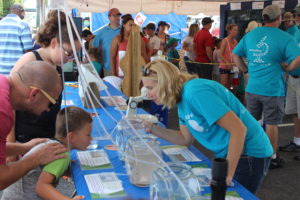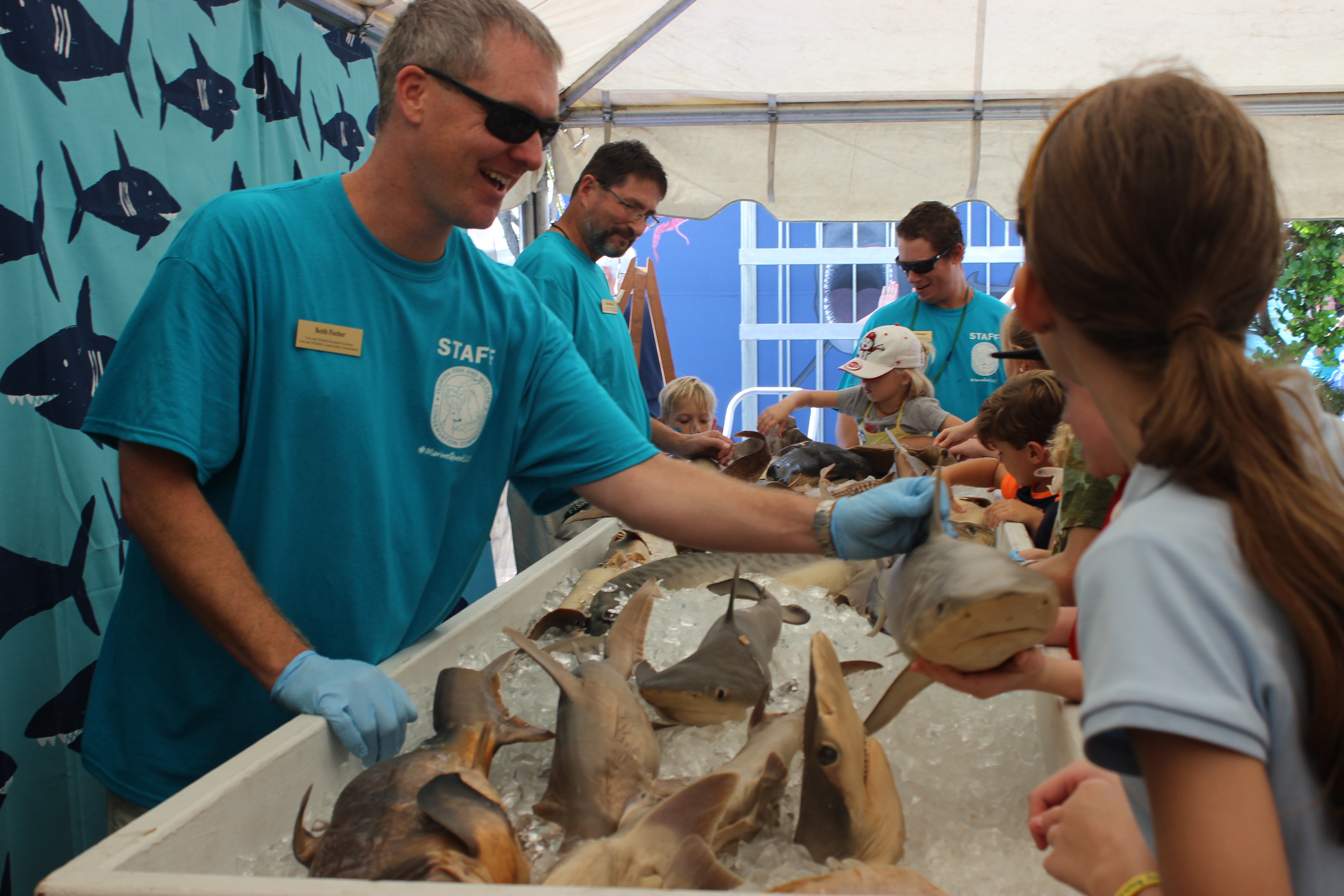By Michael Moore Jr.
Several kids gather around the back of a rescue truck, pulling on a piece of tarp. They hoist a manatee out on a stretcher before gently setting it on the ground.
Upon closer inspection, the manatee more closely resembles a leather couch with eyes. It was stitched together by a local biologist.
The kids were practicing what it’s like to rescue a manatee.
“Anyone who helped rescue the Manatee gets a lollipop,” says one Florida Fish and Wildlife Conservation Commission official, after the exercise.

This is MarineQuest 2017, the annual open house of the Fish and Wildlife Research Institute. In its 23rd year, it has become home to a plethora of live marine, freshwater and other animal exhibits: To the left there are sharks, rays and spiny lobsters. To the right there are sea stars, snakes and alligators.
Its aim? To inspire, educate and get people excited about science.
“Do you want to know what it’s like to fly into a hurricane?” asks Chris Mehta, 27, a doctorate candidate at USF Tampa in geology.
When he’s not studying, he works for the science, engineering and meteorology department of the National Oceanic and Atmospheric Administration.
Mehta isn’t at MarineQuest.
He’s just a few steps away on Harbor Lawn, where the seventh annual St. Petersburg Science Festival is taking place. It is a regional celebration of hands-on science, technology, engineering, art and math. It’s home to over 150 exhibits that stretch all the way to Poynter Park.
Its aim? To inspire, educate and get people excited about science.
MarineQuest and the Science Festival are free events that have been held in conjunction for the past several years.
Hundreds of people flock to the exhibits each year, many of them budding scientists who were inspired to be science-literate by similar events.
“Working for NOAA has been a lifelong dream of mine. I love serving others,” Mehta says, handing out Kermit the frog stickers that say “sky hopper” on them.
He says every day is a new adventure, which sounds cliché, until you hear him describe how they have to direct the nose of the P-3 standard crew airplane down in order to fly directly into the eyewall. When in the eye, it’s calm, which allows them to collect data on things like wind speed and pressure.
He’s at the festival hoping to inspire the next generation of scientists.
Booths from the Florida Aquarium, the Florida Department of Environmental Protection and Mote Marine Laboratory are there to do the same. The day before, more than 1,200 school children were treated to a sneak peak of the exhibits.
Barrie Wilkie has volunteered at Mote Marine Laboratory and Aquarium in Sarasota for 20 years. She’s seen a lot of events like these during her time but was impressed by both the number of people and exhibits.
“There’s a lot of competition here,” she said jokingly.
Wilkie grew up in Aruba, where she says she fell in love with fish and marine life. She spent over 10 years on the floor as a docent, helping give tours and educate the public about ocean conservation. Now, she spends her time educating people at events like these.
“Anytime you can help people understand things better, that’s important,” she said. “You get people watching these shark movies, but if you can touch them and make them fall in love with the animals, that’s special.”
That’s what happened with Domonique Gillen. She’s originally from New Jersey, but her aunt works at Mote Marine. She estimates that she’s visited the aquarium over 50 times. Now she’s a junior marine biology major in the honors program at USF’s College of Marine Science, where she is working on her undergraduate thesis with Dr. Teresa Greely, a professor of biological oceanography.
Gillen hopes to one day be a researcher in the field.

On Saturday she worked a booth at the St. Petersburg Science Festival showing kids “elephant toothpaste,” an exothermic reaction involving hydrogen peroxide, soap, yeast and food coloring that results in an overflow of brightly colored foam.
Seeing the look on kids’ faces as the foam gushes out of the cylinder is priceless, she says. She smiled as she described a curly haired kid from earlier whose face beamed with excitement when she did the experiment.
“Mom, can we do this at home?” he asked.
She “loves the ocean and the complexity of the animals that live there” and us exuberant about the wide range of animals you can study “from dolphins to anglerfish,” but it’s clear that she also loves inspiring the next generation of scientists.
“I think it’s so cool to see how many young kids turned out on a Saturday,” Gillen said. “You have to make them care before they will want to change the world.”
Pictured Above: Keith Fischer, assistant research scientist at the Florida Fish and Wildlife Conservation Commission educated crowds gathered to learn information about sharks. The sharks were preserved in formaldehyde and stored in alcohol to stay intact for the presentation. Michael Moore Jr. | The Crow’s Nest



